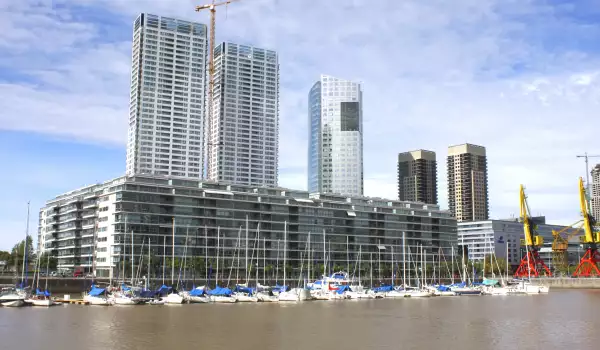La Plata River

Argentina is a country located in South America, bordering Brazil, Paraguay, Bolivia, Chile and Uruguay. Its land is cut by many rivers, some of whom are deep and navigable, almost all of which flow to the Atlantic Basin. Only those in the region of the Patagonian Andes head to the Pacific. The largest deep and navigable rivers - Parana, Paraguay and Uruguay are the in damp and low northeast part of the country where the river network is most developed.
Argentina’s main river is Parana, which springs from the Brazilian plateau near the town of Posadas and descends into the plain, where it becomes navigable to its mouth. In the city of Corrientes, Parana accepts its main tributary - the river Paraguay. The two great rivers Parana and Uruguay gather to join the broad Rio de la Plata, which at the inflow into the Atlantic Ocean forms the largest estuary in the world and the largest bay formed by an estuary, on the planet.
La Plata River, whose name literally translated from Spanish means "Silver River", is the common estuary of Paraná River and Uruguay River’s flow into the ocean. The length of La Plata is 290 km. At the confluence of the two rivers, La Plata’s width is 48 km, and from there onwards the river expands. In the merger with the ocean, La Plata is 220 km wide, which earns it the position of the widest estuary in the world.
The vast La Plata serves as a natural border between Argentina and Uruguay. The capitals of both countries - Buenos Aires and Montevideo, are arranged respectively on the right and left bank of the river. Argentina’s name itself comes from the Latin "argentum" (silver). The first Spanish conquistadors discovered the Rio de la Plata and called it the Silver River in 1516, probably because the natives gave silver gifts to the shipwrecked survivors of the expedition of Juan Díaz de Solís, which actually gave Argentina its name.
The La Plata travels about one fifth of the territory of South America and its catchment basin is the second largest on the continent after that of the Amazon. It includes the lands of Southeast Bolivia, southern and central Brazil, the whole of Paraguay, most of Uruguay and northern Argentina. In La Plata River live very important species such as turtles and dolphins.
Magellan found a map from previous trips, according to which the broad estuary of the River La Plata in South America is a Strait that connects the continent to the Pacific Ocean. He decided to explore this route to reach the Spice Islands, which was key to the strategic and tremendously lucrative trade in spices. Magellan and his team sailed south along the east coast of South America and January 10, 1520 stopped at the mouth of La Plata.
At the bottom of the delta of the Rio de la Plata, on the left bank of the giant river is located the Federal Capital of Argentina - Buenos Aires. Today, the City of Silver River is still a reference center for the continent's second largest Spanish-speaking city after Mexico. The capital is home to more than 13 million people, for whom 200 square km are not enough and the large metropolis is gradually growing along the coast of La Plata in all directions.
All residents of Buenos Aires have the common name "portenyo '- 'resident of the port". The moniker comes from the founding of Buenos Aires, which was created as a starting port of La Plata estuary on the way across the Atlantic to the inland. Even today the Argentine port city in La Plata, with its 40 km of quays is the largest in Latin America and is one of the ten most active of its kind, worldwide.















